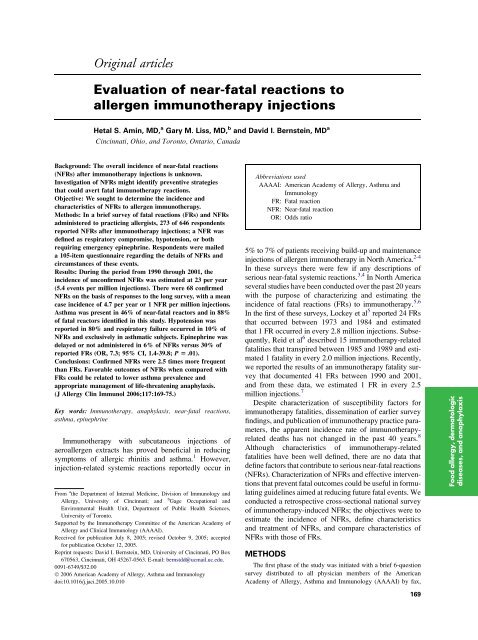Immunotherapy Safety for the Primary Care ... - U.S. Coast Guard
Immunotherapy Safety for the Primary Care ... - U.S. Coast Guard
Immunotherapy Safety for the Primary Care ... - U.S. Coast Guard
You also want an ePaper? Increase the reach of your titles
YUMPU automatically turns print PDFs into web optimized ePapers that Google loves.
Original articles<br />
Evaluation of near-fatal reactions to<br />
allergen immuno<strong>the</strong>rapy injections<br />
Hetal S. Amin, MD, a Gary M. Liss, MD, b and David I. Bernstein, MD a<br />
Cincinnati, Ohio, and Toronto, Ontario, Canada<br />
Background: The overall incidence of near-fatal reactions<br />
(NFRs) after immuno<strong>the</strong>rapy injections is unknown.<br />
Investigation of NFRs might identify preventive strategies<br />
that could avert fatal immuno<strong>the</strong>rapy reactions.<br />
Objective: We sought to determine <strong>the</strong> incidence and<br />
characteristics of NFRs to allergen immuno<strong>the</strong>rapy.<br />
Methods: In a brief survey of fatal reactions (FRs) and NFRs<br />
administered to practicing allergists, 273 of 646 respondents<br />
reported NFRs after immuno<strong>the</strong>rapy injections; a NFR was<br />
defined as respiratory compromise, hypotension, or both<br />
requiring emergency epinephrine. Respondents were mailed<br />
a 105-item questionnaire regarding <strong>the</strong> details of NFRs and<br />
circumstances of <strong>the</strong>se events.<br />
Results: During <strong>the</strong> period from 1990 through 2001, <strong>the</strong><br />
incidence of unconfirmed NFRs was estimated at 23 per year<br />
(5.4 events per million injections). There were 68 confirmed<br />
NFRs on <strong>the</strong> basis of responses to <strong>the</strong> long survey, with a mean<br />
case incidence of 4.7 per year or 1 NFR per million injections.<br />
Asthma was present in 46% of near-fatal reactors and in 88%<br />
of fatal reactors identified in this study. Hypotension was<br />
reported in 80% and respiratory failure occurred in 10% of<br />
NFRs and exclusively in asthmatic subjects. Epinephrine was<br />
delayed or not administered in 6% of NFRs versus 30% of<br />
reported FRs (OR, 7.3; 95% CI, 1.4-39.8; P 5 .01).<br />
Conclusions: Confirmed NFRs were 2.5 times more frequent<br />
than FRs. Favorable outcomes of NFRs when compared with<br />
FRs could be related to lower asthma prevalence and<br />
appropriate management of life-threatening anaphylaxis.<br />
(J Allergy Clin Immunol 2006;117:169-75.)<br />
Key words: <strong>Immuno<strong>the</strong>rapy</strong>, anaphylaxis, near-fatal reactions,<br />
asthma, epinephrine<br />
<strong>Immuno<strong>the</strong>rapy</strong> with subcutaneous injections of<br />
aeroallergen extracts has proved beneficial in reducing<br />
symptoms of allergic rhinitis and asthma. 1 However,<br />
injection-related systemic reactions reportedly occur in<br />
From a <strong>the</strong> Department of Internal Medicine, Division of Immunology and<br />
Allergy, University of Cincinnati; and b Gage Occupational and<br />
Environmental Health Unit, Department of Public Health Sciences,<br />
University of Toronto.<br />
Supported by <strong>the</strong> <strong>Immuno<strong>the</strong>rapy</strong> Committee of <strong>the</strong> American Academy of<br />
Allergy and Clinical Immunology (AAAAI).<br />
Received <strong>for</strong> publication July 8, 2005; revised October 9, 2005; accepted<br />
<strong>for</strong> publication October 12, 2005.<br />
Reprint requests: David I. Bernstein, MD, University of Cincinnati, PO Box<br />
670563, Cincinnati, OH 45267-0563. E-mail: bernstdd@ucmail.uc.edu.<br />
0091-6749/$32.00<br />
Ó 2006 American Academy of Allergy, Asthma and Immunology<br />
doi:10.1016/j.jaci.2005.10.010<br />
Abbreviations used<br />
AAAAI: American Academy of Allergy, Asthma and<br />
Immunology<br />
FR: Fatal reaction<br />
NFR: Near-fatal reaction<br />
OR: Odds ratio<br />
5% to 7% of patients receiving build-up and maintenance<br />
injections of allergen immuno<strong>the</strong>rapy in North America. 2-4<br />
In <strong>the</strong>se surveys <strong>the</strong>re were few if any descriptions of<br />
serious near-fatal systemic reactions. 3,4 In North America<br />
several studies have been conducted over <strong>the</strong> past 20 years<br />
with <strong>the</strong> purpose of characterizing and estimating <strong>the</strong><br />
incidence of fatal reactions (FRs) to immuno<strong>the</strong>rapy. 5,6<br />
In <strong>the</strong> first of <strong>the</strong>se surveys, Lockey et al 5 reported 24 FRs<br />
that occurred between 1973 and 1984 and estimated<br />
that 1 FR occurred in every 2.8 million injections. Subsequently,<br />
Reid et al 6 described 15 immuno<strong>the</strong>rapy-related<br />
fatalities that transpired between 1985 and 1989 and estimated<br />
1 fatality in every 2.0 million injections. Recently,<br />
we reported <strong>the</strong> results of an immuno<strong>the</strong>rapy fatality survey<br />
that documented 41 FRs between 1990 and 2001,<br />
and from <strong>the</strong>se data, we estimated 1 FR in every 2.5<br />
million injections. 7<br />
Despite characterization of susceptibility factors <strong>for</strong><br />
immuno<strong>the</strong>rapy fatalities, dissemination of earlier survey<br />
findings, and publication of immuno<strong>the</strong>rapy practice parameters,<br />
<strong>the</strong> apparent incidence rate of immuno<strong>the</strong>rapyrelated<br />
deaths has not changed in <strong>the</strong> past 40 years. 8<br />
Although characteristics of immuno<strong>the</strong>rapy-related<br />
fatalities have been well defined, <strong>the</strong>re are no data that<br />
define factors that contribute to serious near-fatal reactions<br />
(NFRs). Characterization of NFRs and effective interventions<br />
that prevent fatal outcomes could be useful in <strong>for</strong>mulating<br />
guidelines aimed at reducing future fatal events. We<br />
conducted a retrospective cross-sectional national survey<br />
of immuno<strong>the</strong>rapy-induced NFRs; <strong>the</strong> objectives were to<br />
estimate <strong>the</strong> incidence of NFRs, define characteristics<br />
and treatment of NFRs, and compare characteristics of<br />
NFRs with those of FRs.<br />
METHODS<br />
The first phase of <strong>the</strong> study was initiated with a brief 6-question<br />
survey distributed to all physician members of <strong>the</strong> American<br />
Academy of Allergy, Asthma and Immunology (AAAAI) by fax,<br />
169<br />
Food allergy, dermatologic<br />
diseases, and anaphylaxis
















